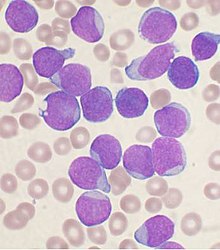Leukemia
Leukemia or leukaemia is a cancer of white blood cells and bone marrow. When a person has leukemia, the body creates too many white blood cells (leukocytes).

There are many kinds of leukemia. Leukemia is part of a bigger group of diseases, the blood cancers (hematological neoplasms). Without treatment, leukemia may lead to death within weeks, months, or years. The life of the person depends upon the type of leukemia.
In 2000, about 256,000 children and adults around the world developed some form of leukemia, and 209,000 died from it.[1] About 90% of all leukemias are seen in adults.[2]
Four major types of leukemia change
Leukemia can be either acute or chronic. Acute leukemia usually grows quickly. Chronic leukemia grows slowly.
Leukemia can also affect two different types of white blood cells. These are lymphoid cells and young granulocyte cells (which are called myelocytes).
For this reason, all of the different forms of leukemia are divided into four main types:
- Acute lymphocytic leukemia (ALL) is the most common type of leukemia. It is common in young children but can also be seen in old people.
- Chronic lymphocytic leukemia (CLL) is usually seen in people over the age of 55. Children almost never have this.
- Acute myelogenous leukemia (AML) is seen more commonly in adults than in children.
- Chronic myelogenous leukemia (CML) happens mostly in adults.
Causes and risk factors change
The causes of most types of leukemia are not known. In general, all cancers have a breakdown in the normal way cell division is controlled. Most likely, the different kinds of leukemias have different causes. The known causes account for relatively few cases.[3] Most of the causes are outside our control.
Researchers believe that some things may influence whether a person develops leukemia:
- Exposure to Ionizing radiation
- Exposure to certain chemicals, for example benzene.
- Certain viruses
- Treatment with certain drugs that influence how cells develop; e.g. treatment of a tumor; Chemotherapy
- Certain genetic factors.
Viruses that are believed to cause leukemia include:
Fanconi anemia is also a risk factor for developing acute myelogenous leukemia.
Treatment change
Most cases of leukemia are treated with many drugs, which are usually combined into a chemotherapy program. In some cases, radiation therapies or bone marrow transplants are done.
Leukemia inhibitory factor change
Leukemia inhibitory factor, or LIF, is an interleukin 6 class cytokin. It affects cell growth by inhibiting differentiation. When LIF levels drop, the cells differentiate.
References change
- ↑ "WHO Disease and injury country estimates". World Health Organization. 2009. Retrieved 2009-11-11.
- ↑ "SEER Stat Fact Sheets: Leukemia". National Cancer Institute. 2011.
Approximately 10.8% were diagnosed under age 20
- ↑ Ross J.A.; et al. (2002). "Diet and risk of leukemia in the Iowa Women's Health Study". Cancer Epidemiol. Biomarkers Prev. 11 (8): 777–81. PMID 12163333.